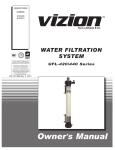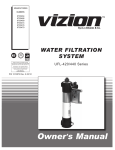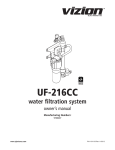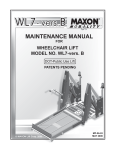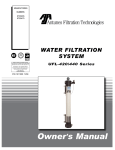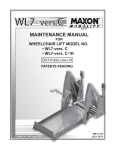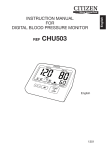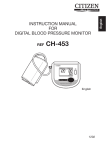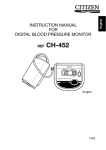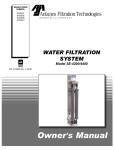Download Antunes, AJ UF-420/440 Specifications
Transcript
MANUFACTURING NUMBERS: 9700800 9700810 9700820 9700830 9700840 9700850 Cartridge Tested and Certified by NSF International against NSF/ANSI Standard 42 and 53 for the reduction of: Standard No. 42: Aesthetic Effects Nominal Particulate Reduction Class I Standard No. 53: Health Effects Cyst Reduction Turbidity Reduction. TOTAL ASSURANCE PACKAGE TAP-400 Series P/N 1010942 10/06 Owner ’s Manual TAP (TOTAL ASSURANCE PACKAGE) TABLE OF CONTENTS Owner Information .....................................................2 General ......................................................................2 Warranty Information .................................................2 Service/Technical Assistance ....................................3 Important Safety Information ....................................3 Specifications .............................................................5 Electrical Cord & Plug Configurations .......................5 Dimensions - TAP-442...............................................5 Replacement Cartridges ............................................5 Performance Data Sheet ............................................7 Filter Cartridge Capacities .........................................7 System Capacities .....................................................7 Water Condition Equipment Guidelines...................7 Performance Claims for Percent Reduction ..............7 Installation...................................................................8 System Overview.......................................................8 Unpacking ..................................................................8 Equipment Setup .......................................................9 Mounting the System .............................................. 10 Attaching the Check Valve Assembly ......................11 Attaching the Drain Hosing......................................11 Attaching the Rinse Hose ........................................11 Attaching to the System Inlet ................................. 12 Attaching to the Filtered Water Permeate Outlet ... 12 Starting the System ................................................ 12 Rinsing the Ultrafilter Cartridge .............................. 13 Rinsing the Carbon Elements and Plumbing ......... 14 Sanitizing the System and Lines ............................ 14 Operation ................................................................ 15 Manual Flushing ..................................................... 15 System Power Loss ............................................... 15 Operation...................................................................15 Viewing Filtration Element Data ............................. 15 Viewing Sensor Readings ...................................... 15 Replacing Carbon Elements................................... 16 Maintenance ..............................................................16 Replacing the Ultrafilter Cartridge .......................... 17 System Sanitization ................................................ 18 Accessing TAP Controller Features........................ 19 Service Menu Access ............................................. 20 Troubleshooting .......................................................21 Wiring Diagram .........................................................23 Recommended Equipment Schematic ...................23 Replacement parts ...................................................24 Limited Warranty ......................................Back Cover OWNER INFORMATION General If the system arrives damaged, contact the carrier immediately and file a damage claim with them. Save all packing materials when filing a claim. Freight damage claims are the responsibility of the purchaser and are not covered under warranty. The warranty does not extend to: Antunes Filtration Technologies, Division of A.J. Antunes & Co., has partnered with companies from around the globe to produce the Total Assurance Package (TAP) Series water filtration systems. The TAP Series is an innovative filtration system that uses NeoH capillary membranes as well as carbon element to provide the latest innovation in filtration technology. • Damages caused in shipment or damage as result of improper use. • Installation of electrical service. This manual provides the safety, installation and operating procedures for the TAP-Series water filtration systems. We recommend that all information contained in this manual be read prior to installing and operating the system. • Normal maintenance as outlined in this manual. • Malfunction resulting from improper maintenance. • Damage from moisture leaking into electrical components. Your TAP-Series system is manufactured from the finest materials available and is assembled to AFT’s strict quality standards. This system has been tested at the factory to ensure dependable trouble-free operation. • Normal maintenance as outlined in this manual. • Damage from tampering with, removal of, or changing any preset control or safety device. Warranty Information Please read the full text of the Limited Warranty in this manual. IMPORTANT! Keep these instructions for future reference. If the system changes ownership, be sure this manual accompanies the equipment. 2 P/N 1010942 10/06 TAP (TOTAL ASSURANCE PACKAGE) OWNER INFORMATION (continued) Service/Technical Assistance Purchased From: If you experience any problems with the installation or operation of your system, contact Antunes Filtration Technologies at 1-630-784-1000, or toll free in the United States at 1-800-253-2991. Date of Purchase: Model No.: Serial No.: Fill in the information in the next column and have it handy when calling for assistance. The serial number is on the specification plate located on the system. Mfg. No.: IMPORTANT A.J. Antunes and Company reserves the right to change specifications and product design without notice. Such revisions do not entitle the buyer to corresponding changes, improvements, additions or replacements for previously purchased equipment. IMPORTANT SAFETY INFORMATION In addition to the warnings and cautions in this manual, use the following guidelines for safe operation of the system. Throughout this manual, you will find the following safety words and symbols that signify important safety issues with regards to operating or maintaining the system. • Read all instructions before using equipment. • Install or locate the equipment only for its intended use as described in this manual. Do not use corrosive chemicals in this equipment. WARNING GENERAL WARNING. Indicates information important to the proper operation of the equipment. Failure to observe may result in damage to the equipment and/or severe bodily injury or death. • Do not operate this equipment if it has a damaged cord or plug; if it is not working properly, or if it has been damaged or dropped. • This equipment should be serviced by qualified personnel only. Contact Antunes Filtration Technologies for repair. WARNING • Do not immerse cord or plug in water. • Keep cord away from heated surfaces. ELECTRICAL WARNING. Indicates information relating to possible shock hazard. Failure to observe may result in damage to the equipment and/or severe bodily injury or death. CAUTION GENERAL CAUTION. Indicates information important to the proper operation of the equipment. Failure to observe may result in damage to the equipment. P/N 1010942 10/06 3 TAP (TOTAL ASSURANCE PACKAGE) IMPORTANT SAFETY INFORMATION (continued) Protect from high temperatures or abrupt variation in temperature The following warnings and cautions appear throughout this manual and should be carefully observed. The maximum operating temperature is 104°F (40°C). Avoid abrupt variations in temperature. Any temperature variation should be made slowly. • Disconnect the power source before performing any service or maintenance on the system. • All electrical connections must be in accordance with local electrical codes and any other applicable codes. Protect from rough handling or dropping Mechanical damage, external breakage, and/or internal breakage of the filter can result if the system is dropped or bumped. Handle with care at all times during transportation and installation. • WARNING ELECTRICAL SHOCK HAZARD. FAILURE TO FOLLOW THESE INSTRUCTIONS COULD RESULT IN SERIOUS INJURY OR DEATH. - Do not modify the power supply cord plug. If it does not fit the outlet, have a proper outlet installed by a qualified electrician. - Do not use an extension cord with this appliance. Protect from organic solvents and concentrated acids Prevent any and all contact of the membrane with strong solvents, solvents containing chlorine, or concentrated acids. Do not use strong solvents or concentrated acids on any plastic parts of the filter system. Examples of some solvents to avoid: acetone, methyl acetate (nail polish remover); hexane (spot removers); turpentine, toluene (paint thinners); dry cleaning solutions, insecticides. • If the supply cord is damaged, it must be replaced by the manufacturer or its service agent or a similarly qualified person. Protect from abrasive material • This equipment is to be installed to comply with the local plumbing code and any other applicable code. The membranes must be protected from abrasive materials like shavings left in a pipe. Abrasive materials in contact with the membrane can cause irreversible damage to the membrane. All pipes must be flushed clean before installing the filter. All plastic parts of the filter system must be protected from sharp objects like knives, sand paper or other tools. Cutting or nicking a plastic part can weaken it and cause a leak. Do not use abrasive cleansers on any plastic parts. • Water pressure must not exceed the membrane differential pressure of 45 psig (3.1 bar). To reduce water pressure, install a water pressure regulator and set the system inlet water pressure to 45 psi (3.1 bar). Protect from becoming dry Protect from water hammer If the membrane dries out, irreversible damage to the membrane may result. Protect the filter from becoming dry by keeping it wet and sealed at all times. The system must be protected from shock, pressure surges, or pulsation that may occur inside water pipes. Water hammer occurs in pipes when a valve or faucet shuts quickly. Install a water hammer arrestor (pressure vessel containing compressed air separated from the water by a diaphragm) to reduce pressure shock. Protect from freezing If the membrane freezes during operation or storage, irreversible damage to the membrane and brittle cracking of the cartridge or housing may result. Protect from direct sunlight or other UV sources Avoid long-term exposure to direct sunlight or other UV sources. The filter should be stored in a dark location. 4 P/N 1010942 10/06 TAP (TOTAL ASSURANCE PACKAGE) SPECIFICATIONS Replacement Cartridges Electrical Cord & Plug Configurations Kit Model Number Description 7000525 120 VAC., NEMA 1-15P, 500mA 7000524 7000523 Replacement Cartridge Configuration 230 VAC., CEE 7/16, 500mA Part Number TAP-420 Series Ultrafilter L-420 7000411 TAP-440 Series Ultrafilter L-440 7000412 TAP-421, 441 Single pack Carbon 7000669 TAP-422, 442 Dual pack Carbon 7000670 CAUTION All electrical connections must be in accordance with local electrical codes and any other applicable codes. 220 VAC., HKH-01, 500mA Dimensions - TAP-442 24" (61 cm) 30" (76 cm) 16" (41 cm) 37” (94 cm) 38-1/2” (98 cm) 51-1/2” (131 cm) NOTE: The TAP Series system Depth is 13 inches. Figure 1. Dimensions P/N 1010942 10/06 5 TAP (TOTAL ASSURANCE PACKAGE) SPECIFICATIONS (continued) System “Smart Controler” Drain Solenoid Valve (autmatic) System Drain Connection Carbon Element Housing Permeate Solenoid Valve Automatic Rinse Valve (manual) UFL Ultrafiltration Cartridge Flow Meter Dual Check Valve Assembly with Outlet Pressure Guage Permeate Tank Differential Pressure Sensor Outlet Valve (manual) Inlet Valve (manual) System Outlet Carbon Element Housing Inlet Solenoid Valve (automatic) System Inlet Figure 1. TAP-442 System Components 6 P/N 1010942 10/06 TAP (TOTAL ASSURANCE PACKAGE) PERFORMANCE DATA SHEET Filter Cartridge Capacities Maximum Operating Pressure Maximum Operating Temp. Minimum Operating Temp. Maximum Membrane Differential Pressure pH Range MWCO Cartridge Tested and Certified by NSF International against NSF/ANSI Standard 42 and 53 for the reduction of: 100 psig (690 kPa) 104°F (40°C) 40° F (4° C) Standard No. 42: Aesthetic Effects Nominal Particulate Reduction Class I Standard No. 53: Health Effects Cyst Reduction Turbidity Reduction 45 PSI (3.1 Bar) 3-10 100 kD System Capacities Model Mfg. No. Gal./Liters Per Min. (max) TAP-420 9710800 TAP-421 9700810 Carbon Element Capacity UF Length 0 5 gal. (19 liters) 60,000 gal. (227,000 liters) 0 20 in. (51 cm) 1 TAP-422 9700820 120,000 gal. (454,000 liters) 2 TAP-440 9700830 0 0 TAP-441 9700840 10 gal. (38 liters) TAP-442 9700850 60,000 gal. (227,000 liters) Cartridge has been tested according to NSF/ANSI Standard 42 and 53 for reduction of the substances listed below. The concentration of the indicated substances in water entering the system was reduced to a concentration less than or equal to the permissible limit for water leaving the system, as specified in NSF/ANSI 42 or 53. While testing was performed under standard laboratory conditions, actual performance may vary. Number of Carbons 40 in. (102 cm) 120,000 gal. (454,000 liters) Performance Claims for Percent Reduction Substance Influent Challenge Concentration Reduction Requirement cyst1 minimum 50,000/L 99.95% Turbidity 11+/1 NTU ≤ 0.5 NTU Particulate Class I Particles 0.5 to < 1µm at least 10,000 particles /mL 85% 1 2 1 based on the use of microspheres or Cryptosporium parvum oocysts NOTE: The NSF Information provided above applies to the TAP system’s Ultra-Filter Cartridge. WATER CONDITION EQUIPMENT GUIDELINES The following table describes the required or recommended equipment to be used with your filtration system based on the Inlet Water Pressure and Inlet Turbidity. If your Inlet Water Pressure (PSI) is... And your Inlet Turbidity (NTU) is... Then the Additional Equipment required or recommended is... Less than 45 psi Less than 1 NTU Required: No additional equipment. Recommended: Inlet Water Strainer (180 micron/80 mesh screen) Greater than 45 psi Less than 1 NTU Required: Pressure Regulator Recommended: Inlet Water Strainer (180 micron/80 mesh screen) Less than 45 psi Greater than 1 NTU Required: Inlet Water Strainer (180 micron/80 mesh screen) Greater than 45 psi Greater than 1 NTU Required: Inlet Water Strainer (180 micron/80 mesh screen) P/N 1010942 10/06 7 TAP (TOTAL ASSURANCE PACKAGE) INSTALLATION System Overview The TAP System has two components that improve the quality of the water. The first (UFL-420/440 ultrafilter) removes particulate material, cysts, bacteria, and virus. The second (carbon elements) remove chlorine, tastes and odors. The TAP system is designed to be self-cleaning by use of solenoid valves, sensing components, and a Smart Controller. Unpacking Open the large box. It should contain the following components: • Plate mounted TAP-400 Series system with UFL cartridge installed • One Dual Check Valve assembly with gauge • Two clear Carbon Element Housings with Carbon Elements installed • One 20 foot coil of flexible hose • One accessory bag containing filter wrench and hose clamps • Owner’s Manual NOTE: The system is also shipped with the power transformer selected at time of purchase. Remove all packing materials and protective coverings from the system. Figure 2. TAP System Remove the information packet. To prevent any delay in obtaining warranty coverage, fill out and mail the warranty card. NOTE: If any parts are damaged, contact Antunes Filtration Technologies IMMEDIATELY at 800-2532991 (toll free in the U.S. and Canada) or 630-7841000. 8 P/N 1010942 10/06 TAP (TOTAL ASSURANCE PACKAGE) INSTALLATION (continued) Equipment Setup If soldered plumbing is used, do not apply heat to, or near, the filtration system. The use of union (O-ring seal) connections is highly recommended for ease of installation and future servicing. GENERAL When placing the system into service, pay attention to the following guidelines: SUGGESTED TOOLS AND SUPPLIES FOR INSTALLATION • Do not immerse cord or plug in water. The following tools and supplies are suggested to make the installation easier: • Keep cord away from heated surfaces. ELECTRICAL Ensure the line voltage corresponds to the stated voltage on the specification label. Make sure the plug on the power cord matches the appropriate outlet. For proper operation, and to ensure the highest quality water, do not connect the system to a switched electrical outlet. • Pipe Wrenches The TAP system uses the following connections (Fig. 1): When making a plumbing connection to the system, use a back-up wrench on the supporting plumbing. Always use a quality, approved pipe sealant or Teflon® tape on pipe threads. Be careful not to get the pipe sealant inside the pipe when making connections. FLOW REGULATOR ASSEMBLY The TAP system uses a Water Flow Regulator Assembly that controls the flow of water into the unit. This assembly consists of a white threaded male connector and a color-coded Flow Regulator. The unit MUST be operated with the appropriate Water Flow Regulator Assembly. DO NOT over tighten the connections. Use plastic fittings when connecting to the plastic connections of the system. This reduces the possibility of cracking the connections due to overtightening. SYSTEM TAP-440, 441, and 442 Units: Use a BLACK and WHITE Water Flow Regulator Assembly (10 gpm gallons per minute) System Display 1 2 3 • Garden Hose, 3/4” CAUTION Water pressure must not exceed a membrane differential pressure of 45 psig. To reduce water pressure, install a water pressure regulator and set the water pressure to 45 psi. System Inlet 1/2” NPT System Outlet (Product Water) 1/2” NPT Drain 3/4” NPT Rinse Outlet 3/4” GHT (Garden Hose) CARBON • Pipe dope or Teflon® tape CAUTION This equipment is to be installed to comply with the basic plumbing code of the Building Officials and Code Administrators, Inc. (BOCA) and the Food Service Sanitation Manual of the Food and Drug Administration (FDA). NOTE: The system must be connected to the COLD water line. Do not connect the system to the hot water line. ULTRAFILTER • Level • Two Gallon Bucket • Fresh 5-1/4% liquid chlorine bleach (such as Clorox®) NOTE: The TAP system is designed to use tap water not to exceed 104°F (40°C) or 45 psig (310 kPa). % REMAINING • Adjustable Wrenches • Drill with Bits • Tape Measure PLUMBING • • • • • Screwdriver TAP-420, 421, and 422 Units: Use a GREEN and WHITE Water Flow Regulator Assembly (5 gpm) VIEW CAUTION Water Flow Regulator Assemblies are NOT interchangeable. Operating the system with the wrong Water Flow Regulator or without a regulator can damage the system, cause personal injury, and voids the warranty! NON-PEAK TIME WHEN NEEDED SYSTEM FLUSH Figure 3. TAP System Control Panel P/N 1010942 10/06 9 TAP (TOTAL ASSURANCE PACKAGE) INSTALLATION (continued) INLET WATER PLUMBING CAUTION Due to its weight and size, the TAP system should be mounted by 2 or more individuals. If desired, a “T” or Cross Fitting with cap or plug can be installed between the Inlet Valve and the System Inlet. This fitting can be used for draining and sanitizing the system and downstream plumbing. Mounting the System Before mounting the TAP system, please consider the items listed in Mounting Requirements. The plumbing leading to the system must be flushed clear of all debris before connecting to the system inlet. Hold a bucket at the inlet water line and slowly open the inlet water valve. Allow the pipe to flush until all debris is removed. MOUNTING REQUIREMENTS • The system must be mounted with sufficient access for cartridge replacement. The TAP system is 30 inches wide, 51-1/2 inches tall, and 13 inches deep. The system should be mounted as close to the ceiling as possible to allow proper access when changing cartridges. • The system must be mounted with mounting hardware capable of supporting 120 lbs or more of weight. • The system must be mounted near an appropriate electrical outlet. • The system must be mounted near a drain for flushing operations. • The system must be installed in front of all consumable water filtration processes. DRAIN LINE PLUMBING The drain line is used to flush away the particle buildup when cleaning the ultra filter. The drain line must be able to support the flow rate when the system flushes. The flow rate from the flush depends on the inlet water pressure, inlet pipe size, and system selected. The drain line should be as large or larger than the inlet plumbing line. The drain line should be as short as possible, sloping downward without kinks or loops. Be sure the drain used is not blocked or restricted. Protect the system from possible back contamination by installing an air gap between the drain connection of the system and the drain (Figure 4). This gap in the line, with no physical contact between the system and drain, prevents contamination of the system in the event of a backed-up drain. The TAP System is pre-assembled to a back plate. The back plate has mounting holes (16” and 24” on- center) on the top and bottom. Be sure to use both top and bottom mounting holes to support the weight of the system. Some mounting holes are covered by the UFL Cartridge. Plan your mounting accordingly.. NOTE: Make sure the end of the drain line is positioned and secured at least 2 inches above the drain so that the water flow is directed into the drain without splashing. Secure End Drain Line from System Drain Line from System 2” (5.1 cm) minimum Secure End Standpipe 2” (5.1 cm) minimum Floor Drain Drain Figure 4. Proper Draining 10 P/N 1010942 10/06 TAP (TOTAL ASSURANCE PACKAGE) INSTALLATION (continued) Attaching the Check Valve Assembly Attaching the Drain Hosing The system is shipped with a Dual Check Valve assembly attached to the system outlet (Figure 5). This assembly can be detached from the system for ease of mounting, but must be reattached to the system after mounting. Refer to Figure 4 and follow these steps: The TAP System is shipped with a coil of flexible hose (20 feet) designed to direct the Drain Valve Solenoid water to the drain. Refer to Figure 6 and follow these steps: 1. Cut the flexible hose (provided) so that the hose reaches the drain from the appropriate valve. 1. Insert the Dual Check Valve assembly into the System Outlet. 2. Connect one end of the hose to the barbed fitting on the Drain Valve Solenoid and secure with one of the provided hose clamps. 2. Make sure the Dual Check Valve assembly is fully inserted into the System Outlet fitting. NOTE: Do not remove the pipe nipple and the connected System Outlet Valve from the Dual Check Valve assembly. al C Du NOTE: The drain MUST be able to accommodate a drain flow 10 gpm. The drain hose MUST have an air gap between the end of the hose and the drain. al heck V ve Assem bly Check Valve Housing Dual Check Valve Assy. System Connection (Note: Minimum Gap 3. Direct the other end of this hose to the drain. Attaching the Rinse Hose System Connection The TAP system has a standard 3/4” garden hose connection at the Rinse Valve. A 3/4” garden hose (not supplied) long enough to reach from this connection to the drain should be used for rinsing. Be sure to install a gasket in the hose end before attaching to the system. Pressure Gauge Outlet Valve 1. Connect the end of the garden hose to the fitting on the rinse valve and tighten. Use a back-up wrench on the fitting if required. 2. Direct the other end of the hose to the drain. Secure as necessary. System Outlet NOTE: the drain MUST be able to accommodate a flow of 10 gpm. Figure 5 Dual Check Valve Assembly 3/4” Garden Hose Connection Secure Hose with Worm Clamp Direct Hose to Drain Drain Solenoid Valve Direct Hose to Drain Rinse Valve Figure 6 Attaching the Drain Hose P/N 1010942 10/06 11 3/4” Garden Hose (Not Supplied) TAP (TOTAL ASSURANCE PACKAGE) INSTALLATION (continued) Attaching to the System Inlet CAUTION Do not use the Rinse Valve connection for consumable water. Because the Carbon Elements are after the Rinse Valve, the Rinse Valve water may have an objectionable taste. The System Inlet (Figure 7) has a 1/2” NPT female thread at the Inlet Valve. Be careful not to over tighten a fitting onto the System Inlet valve. The plastic ball valve can be cracked due to over tightening a fitting into the valve. Use a plastic fitting to connect to the System Inlet. Use an approved pipe thread sealant that is approved for use on PVC fittings. Inlet Solenoid Valve Starting the System NOTE: Be sure that ALL ball valves are closed before starting the system. Inlet Valve Follow these steps to power up the system: 1. After the system is mounted, connect the power supply to the bottom right of the Smart Controller. 2. Plug the wall transformer into an appropriate outlet that has power to it at all times. Inlet Pressure Port for differential Pressure Sensor Inlet Flow control NOTE: Do not plug the power cord into an outlet that will be switched off. Failure to supply power to the system at all times may result in short cartridge life or bad tasting water. System Inlet NOTE: The system is designed to supply water even with the power off. However, with power off, the system will not flush or monitor any usage. Figure 7. TAP System Inlet Assembly Attaching to the Filtered Water Permeate Outlet 3. When powering up the controller for the first time, the internal clock must be set before any other action can take place. The unit beeps as a reminder to set the internal clock. The system outlet (Figure 8) has a 1/2” NPT female thread at the Outlet Valve. Be careful not to over tighten a fitting onto the Outlet Valve. The plastic ball valve can be cracked due to over tightening a fitting into the valve. a. Press and hold (in order) the VIEW, and ▲ buttons until the red SYSTEM LED illuminates and “--“ appears on the display. The unit stops beeping. b. Release all buttons. The system displays “--”. c. Use the ▲ or ▼ buttons to scroll to “01” and press the FLUSH button to start the Clock Set program. d. Use the ▲ and ▼ buttons to set the local date and time and press the FLUSH button after each selection. The clock should be set to local time in the following format: YY; MM; DD; HH (0-23); MM System Outlet NOTE: The clock uses 24 hour time to tell the difference between AM and PM. For example: If the local time is 3:45 PM on July 4, 2006, the clock would be set as: 06; 07; 04; 15: 45. Figure 8. TAP System Outlet It is recommended that a plastic fitting be used in the outlet. Use a drinking water-approved pipe thread sealant that is approved for use on PVC fittings. 12 P/N 1010942 10/06 TAP (TOTAL ASSURANCE PACKAGE) INSTALLATION (continued) Rinsing the Ultrafilter Cartridge Wait for 15 minutes. Water flows through the UFL cartridge and out of the Rinse Valve. After 15 minutes, r2 flashes on the display and the system beeps. The UFL-440 ultrafilter cartridge is pre-installed with the TAP system before shipment. This cartridge must be rinsed before placing the system into operation. Manually close the Rinse Valve. The UFL-440 cartridge should be rinsed using the “06 (Rinse New UFL Membrane Program)” from the Service Menu (described below). 8. Press the FLUSH button to start the r3 stage (No Flow stage). NOTE: The system must be rinsed to remove air and the shipping/storage solution. For maximum quality, the permeate water produced during the rinsing procedure must be discarded. Direct the permeate water produced from this rinsing operation to drain. Wait for 15 minutes. The UFL cartridge remains under pressure without water flow. After 15 minutes, r3 flashes on the display and the system beeps. Manually open the Rinse Valve. 9. Press the FLUSH button to start the r4 stage (Rinse Flow stage). CAUTION Ingesting the protective solution may cause irritation of the gastrointestinal tract, colic, diarrhea, or other similar symptoms. Wait 5 minutes. Water flows through the UFL cartridge and out of the Rinse Valve. After 5 minutes, r4 flashes on the display and the system beeps. Follow these steps to rinse the ultrafilter cartridge. Manually close the Rinse Valve. 1. Manually close the Inlet Valve (Figure 2). 10. Press the FLUSH button to start the r5 stage (Open Drain Solenoid Valve stage). 2. Make sure a drain hose is connected to the Rinse Valve and that the hose is directed to a drain. Wait for 1 minute. Water flows through the UFL housing and out of the Drain Solenoid Valve. 3. Manually open the Rinse Valve (Figure 2). 4. To enter the 06 (Rinse New UFL Membrane Program), press and hold (in order) the VIEW, and ▲ buttons until the red SYSTEM LED illuminates and “ -- ” appears on the display (Figure 3). 11. The system then begins the r6 stage (Close Inlet Solenoid Valve stage). The system completes depressurization and displays d3. 12. The system must then be repressurized using the 08 (Pressurize System) program. To enter the program, press and hold (in order) the VIEW and ▲ buttons until the red SYSTEM LED illuminates and “ -- ” appears on the display. 5. Use the ▲ button to scroll up to “06” and press the FLUSH button to start the rinse program. The system displays d3 and begins to depressurize (the system automatically closes the Inlet Valve and the Permeate Valve and opens the Drain Valve). 13. Use the ▲ button to scroll up to “08” and press the FLUSH button to start the Pressurize System program. 6. Manually open the Inlet Valve. Press the FLUSH button to start the r1 stage (Open Inlet Valve stage). The system repressurizes and makes water available through the system. Wait for 1 minute. Water flows through the UFL cartridge and out of the Drain Valve and the Rinse Valve. After 1 minute, r1 flashes on the display and the system beeps. 7. Press the FLUSH button. The system starts r2 stage to automatically close the Drain Solenoid Valve (Close Drain Solenoid Valve stage). P/N 1010942 10/06 13 TAP (TOTAL ASSURANCE PACKAGE) INSTALLATION (continued) Rinsing the Carbon Elements and Plumbing 1. Follow the procedures in the Rinsing the Ultrafilter Cartridge section of this manual. NOTE: When sanitizing a system with carbon elements, make sure the carbon elements are removed from their housings before sanitizing. The Carbon elements are pre-installed in the clear Carbon Element Housings before shipment. Before placing the system into operation, the Carbon Elements should be rinsed using the procedure below. 2. Shut off the water to the TAP system and open the faucet closest downstream to the system. Allow the system and plumbing to depressurize and drain. If an inlet sanitation fitting is installed, remove the plug or disconnect the water line at the inlet of the system. Allow the water to drain out of the system. NOTE: To ensure that the highest quality water is produced from the system, the Carbon Elements and plumbing leading from the filter system must be flushed clear of carbon fines and other debris. 1. Direct water from the System Outlet to a drain. 3. Pour the bleach into the inlet sanitation fitting or inlet water line using a cup or funnel. Be careful not to spill bleach onto clothing or skin. 2. Turn on the water to the system. Allow water to flow through the Carbon Elements and Carbon Element Housings to flush out trapped air and any debris that may be present. 4. Reattach the plug on the sanitation fitting or inlet water line. To help remove trapped air from the Carbon Element Housings, press the red button on the top of both housings until water just begins to come out of the button. 5. Slowly turn on the water supply and pressurize the system. Allow water to flow out of the open tap until the smell of bleach is present. 3. Flush the Carbon Elements for at least 5 minutes. 6. Close the tap and let the system stand without water flow for at least 15 minutes to allow the bleach to sanitize the pipes. Note: Do not consume the water used for flushing the carbon elements. 7. After 15 minutes without water flow, open the tap and flush until the presence of bleach is gone. Open all other taps in line with the system to flush any bleach from the plumbing. 4. When the Carbon Element flushing is complete, turn off the water to the system and reconnect the water to service. The system is now ready for use. For new piping installations: After making the connection to the System Outlet, open the faucet or tap closest to the filter system, then slowly open the Inlet Valve. Allow the pipe to flush until all debris is removed. 8. Close the taps and depressurize the system. Reinstall the carbon elements or install new carbon elements. Repressurize the system. 9. Press the FLUSH button to remove any trapped air or any remaining bleach. Sanitizing the System and Lines 10. Sanitation is complete. The plumbing must be sanitized to eliminate possible contamination that may have occurred during the installation process. Liquid chlorine bleach (regular bleach, unscented 6 % sodium hypochlorite) can be used to sanitize the plumbing. The amount of bleach to use depends on the system installed and the amount of plumbing downstream of the TAP system. Generally, one ounce (30 ml) of bleach is sufficient to sanitize the system and associated plumbing. Make sure to follow any handling or safety instructions supplied with the bleach. 14 P/N 1010942 10/06 TAP (TOTAL ASSURANCE PACKAGE) OPERATION Operation To turn off the audio alert, press and release both the ▲ and ▼ buttons at the same time. The TAP system is designed to operate with little to no user intervention. The system monitors and flushes itself automatically. NOTE: Be sure to restore power to the system. The system displays the EV-21 code when power is restored to the system. Manual Flushing CAUTION The system will continue to filter water even after a power loss but it will NOT flush. Therefore, running the system without power may shorten the life of the filtration elements. Make sure the system always has power. The TAP system is designed to automatically flush but can also be manually flushed when desired. To manually flush the system: 1. Press and hold the FLUSH button for 3 to 4 seconds. 2. The system enters the FLUSH program and automatically performs the following stages while displaying the stage name on the display throughout the Flush process: Viewing Filtration Element Data The TAP system monitors the lifespan of the filtration elements and can display the percent-of-life remaining for the selected component. • F1 (Close Permeate Solenoid Valve stage) • F2 (Close Inlet Solenoid Valve stage) Press the VIEW button to cycle through the Ultrafilter and Carbon LEDs. Pressing the VIEW button again steps to the next component. • F3 (Open Drain Solenoid Valve stage) • F4 (Open Inlet Solenoid Valve stage) The system displays the percent-of-life remaining for the selected component in the display. • F5 (Close Drain Solenoid Valve stage) • F6 (Open Permeate Solenoid Valve stage) Viewing Sensor Readings NOTE: The system automatically performs these stages The TAP System uses the Flow Meter and Differential Pressure Sensor to monitor the Flow Rate and Differential Water Pressure respectively. 3. Flushing is complete once the system completes the F6 stage of the FLUSH program. System Power Loss The system also uses measurements to determine when to automatically flush and monitors the effectiveness of the flush operations. To view this data: The TAP system is designed to run with constant power. Thus, the power cord should always be plugged into an appropriate power outlet that will not be switched off. 1. Simultaneously press both the VIEW and ▼ buttons. The Red LED illuminates. In the event of a power loss, the TAP System: 2. Press the VIEW button to scroll through the green LEDS (numbered 1, 2, and 3) which indicate the following data: 1. Aborts any active valve program. 2. Resets the valves to normal operation (pressurized/water available). • LED 1 (top): Used to determine when the system automatically flushes and measures the effectiveness of flush operations. 3. Sounds an alert to notify the operator of the power loss. 4. Records the time of the power loss into the controller memory. • LED 2 (middle): Flow Rate, in gallons per minute (gpm) 5. Displays the EV-20 event code (indicating a loss of power). • LED 3 (bottom): Differential Water Pressure, in pounds per square inch (psi) The system beeps 4 times every 10 seconds for approximately 2 minutes. Then it beeps once every 30 seconds. P/N 1010942 10/06 3. To exit, press the FLUSH button until the red LED turns off. 15 TAP (TOTAL ASSURANCE PACKAGE) MAINTENANCE Replacing Carbon Elements 5. Lubricate the o-ring with an approved food grade lubricant and install into the Carbon Element Housing. The carbon elements must be rinsed to remove Carbon fines due to manufacturing and shipping. For maximum quality, the permeate water produced during the rinsing procedure must be discarded. Direct the permeate water produced from this rinsing operation to drain. 6. Install the new Carbon Element into the Carbon Element Housing. Note: Make sure that the end seal gaskets are in place on both ends of the carbon element. The gasket is retained on the end of the element in the recessed groove. Be careful that the gasket does not fall off the element while placing the element into the bowl. 1. Turn off water to the system by closing both the Inlet valve and Outlet valve. 2. Next, depressurized the system using the “03 (Change Carbon Element)” program. Simultaneously press the VIEW and ▲ buttons. The red system LED illuminates and the system displays “ -- “ on the display. Use the ▲ and ▼ buttons to scroll to 03 and press the FLUSH button. 7. Screw the Carbon Element Housing (containing the Carbon Element) into place. Tighten the Carbon Element Housing until it stops. The housing will come to a hard stop at the end of the thread. Use a filter wrench if necessary. The system automatically performs the 03 program, which consists of the following stages: 8. Repeat Steps 3 through 7 for the other Carbon Element Housing and Carbon Element. • C1 (Close Inlet Valve stage) 9. Direct the outlet of the system to drain. • C2 (Open Drain Valve stage) • C3 (Open Permeate Valve stage) NOTE: It is important to direct the system outlet to drain as the water resulting from Steps 10 through 15 should NOT be used. 3. When the 03 program completes, remove the bottom Carbon Element Housing. Empty any water into a drain and discard the old Carbon Element. See Figure 9. 10. Next, the system must be repressurized using the “08 (Pressurize System)” program. To enter the program, press and hold (in order) the VIEW and ▲ buttons until the red SYSTEM LED illuminates and “ -- “ appears on the display. O-Ring Carbon Element Head Carbon Element Housing 11. Use the ▲ or ▼ buttons to scroll to “08” and press the FLUSH button to start the Pressurize System program. This allows the system to pressurize when the Inlet valve is opened and make water available to the Carbon Elements. Carbon Filter Element 12. Turn on the water to the system by opening the Inlet Valve and allow water to flow through the Carbon Elements and Housings to rinse out trapped air and any carbon fines that may be present. To help remove trapped air from the Carbon Element Housings, press the red button on the top of both housings until water just begins to come out of the button. Figure 9. Replacing the TAP Carbon Element 4. Inspect the o-ring on the Carbon Element Housing. Replace the o-ring if it is cracked, twisted, or missing. 13. Rinse the Carbon Elements for at least 5 minutes. 16 P/N 1010942 10/06 TAP (TOTAL ASSURANCE PACKAGE) MAINTENANCE (continued) NOTE: Do not consume the water used for rinsing the Carbon Elements. Snap Ring 14. When the Carbon element rinsing is complete, manually close the Inlet Valve and reconnect the water to service. End Cap 15. When the system is reconnected, turn on the water by manually opening the Inlet Valve and Outlet Valve. The system is ready for use. End Cap O-Rings Replacing the Ultrafilter Cartridge Ultra Filter Cartridge Cartridge O-Ring Note: It is strongly recommended that new carbon elements be installed after a UFL cartridge is changed. 1. Depressurize the system using the “07 - (Depressurize UFL System)” program. Simultaneously press the VIEW and ▲ buttons. The red system LED illuminates and the system displays “ -- “ on the display. Use the ▲ and ▼ buttons to scroll to 07 and press the FLUSH button. Ultra Filter Housing Cartridge O-Ring End Cap O-Rings The system performs the 07 program, which consists of the following stages: End Cap • d1 (Close Inlet Valve stage) • d2 (Open Drain Valve stage) Snap Ring • d3 (Close Permeate Valve stage) 2. When the 07 program completes, place a bucket under the Ultra Filter Housing. Open the Inlet Drain Valve to drain the system. Figure 10. Replacing the Ultra Filter Element NOTE: Make sure there is enough room below the system to remove the cartridge. 3. Remove the Snap Ring on the bottom end of the ultrafilter housing. Grab the raised lug with a pair of pliers and pull towards the center of the end cap and away. The ring should lift out of its groove. 4. See Figure 10. The lower End Cap, End Cap Oring, and Cartridge should easily drop down out of the housing. If not, pull gently on the end cap to remove the cartridge. NOTE: If the cartridge does not easily come out of the housing, the top End Cap can also be removed for assistance during Step 4. P/N 1010942 10/06 17 TAP (TOTAL ASSURANCE PACKAGE) MAINTENANCE (continued) 5. Inspect the cartridge O-rings and end cap O-ring for nicks or cuts. Replace as needed. 10. Press the End Cap into position until it is fully seated and the Snap Ring groove is visible. 6. Lubricate all O-rings with a food-grade silicone lubricant (Figure 9). Apply a light coating of lubricant to the inside center tube at both ends of the new cartridge. 11. Install the Snap Ring by guiding the non-lugged end into the groove first, pushing outward and working around the ring until it snaps into place. NOTE: Make sure that the Snap Ring is fully seated before turning the water on. 12. The new filtration cartridge must be rinsed before operation. Follow the Rinsing the Ultrafilter Cartridge and Sanitizing the System and Lines procedures in the Installation section of this manual to complete the cartridge change. 13. When rinsing is complete, the system must then be repressurized. Use the ▲ or ▼ buttons to scroll to “08” and press the FLUSH button to start the Pressurize program. The system will repressurize and make water available through the system. System Sanitization Figure 9. Lubricating O-Rings 7. Record the serial number of the new cartridge. The cartridge serial number is engraved on one end of the outer tube (for example: 05K 12013). Over time and use, the plumbing downstream from the system may require sanitization. The system and downstream plumbing should be sanitized at least once a year. When necessary, follow the Sanitizing the System and Lines procedure in the Installation section of this manual. 8. Install the End Cap O-ring on the End Cap and insert the End Cap into the end of the new cartridge. 9. Position the new cartridge and End Cap below the housing and gently insert into the housing. 18 P/N 1010942 10/06 TAP (TOTAL ASSURANCE PACKAGE) MAINTENANCE (continued) Accessing TAP Controller Features POWER LOSS TO SYSTEM (SYSTEM UNPLUGGED OR SUPPLY INTERRUPTED) • • • • • Any active valve program is aborted Valves reset to normal operations (pressurized, water available) Control “BEEPS” four times every 10 seconds for about two minutes Control “BEEPS” once every 30 seconds Pressing both ▲and ▼ will silence beeper FLUSH (BUTTON) AUTOMATIC OPERATION • • • • • • F1 F2 F3 F4 F5 F6 - Close Permeate Valve - Wait for Flow = 0 or 10 sec - Close Inlet Valve - Open Drain Valve - Wait for Flow = 0 or 20 sec - Open Inlet Valve - Wait for 12 sec - Close Drain Valve - Wait for Flow < 3 or 15 sec - Open Permeate Valve VIEW (BUTTON) – NORMAL OPERATING MODE Toggles between UFL cartridge % of life and Carbon Elements % of life VIEW (BUTTON) – SENSOR READINGS 1. Press and hold (in order): VIEW button and ▼ button. 2. The red System LED illuminates. 3. Repeatedly pushing the VIEW button will scroll through the green LED’s, indicating the following information: LED #1 (Top) VER Value LED #2 (Middle) Flow Rate (gpm) LED #3 (Bottom) Differential Pressure (psid) 4. To exit Sensor Readings, press the FLUSH button until red LED turns off. ERROR CODE DESCRIPTIONS EC-01 - Differential Pressure = 0 psid, Flow Rate > 0 gpm EC-02 - Differential Pressure > 45 psid (at any flow rate) EC-03 - Differential Pressure > 0 psid, Flow Rate = 0 gpm EC-04 - “VER” value < original “Best VER” value EC-05 - Maximum “VER” value exceeded EC-06 - Flush Flow < 0.75 gallon EC-07 - Flow > 10 gpm EC-08 - Insufficient flush EC-09 - NVM data re-initialized EC-10 - Flow switch #1 fail EC-11 - Flow switch #2 fail EC-12 - Flow switches erratic EC-13 - EEPROM bad EVENT CODE DESCRIPTIONS EV-20 - AC power removed EV-21 - AC power restored EV-22 - Carbon Element changed EV-23 - UFL Filter changed EV-24 - Time reached, Flow Rate > 0 EV-25-31 - Internal software events P/N 1010942 10/06 19 TAP (TOTAL ASSURANCE PACKAGE) MAINTENANCE (continued) Service Menu Access Press and hold, in order, the VIEW button and the ▲ button. 1. The red SYSTEM LED illuminates and the “--” appears in the display. 2. Release all buttons. The system displays “--”. 3. Use the ▲ and ▼ buttons to select the desired function: • “--” - Exit Service Level 2 01 - Set Clock (Year; Month; Day; Hour 0-23; Minute) • 02 - Set Flush Time Hour and Minute (Hour 0-23; Minute) • 03 - Change Carbon Element • 04 - Reset Carbon Element Accumulated Total • 05 - Set Maximum Gallons for Carbon Element (x 10,000) • 06 - Rinse New UFL Membrane and reset UFL Total • 07 - Depressurize UFL System • 08 - Pressurize System • 09 - Toggle Valves (Green LED illuminated when valve is closed) • Inlet [“VIEW”] #1; Permeate [“ ▲ “] #2; Drain [“ ▼“ ] #3 10 - Dump User Data • • 11 - Dump Events 13 - Zero Differential Pressure Sensor • 14 - Display Error Codes • 15 - Clear Displayed Error Codes • 20 - Set Valve Times • 21 - Set Forward Flush Time • 22 - Set Maximum VER Value • 23 - Set Flush Trigger Point (VER Value) • • 24 - Reset to Factory Values 5. Press the FLUSH button to activate the desired function. 6. To exit the Service Menu, press the FLUSH button until the red LED turns off. PROGRAM DESCRIPTIONS • Simultaneously pressing the ▲ and ▼ buttons aborts any active program. 03 - (Change Carbon Element) • • • C1 - Close Inlet Valve stage C2 - Open Drain Valve stage C3 - Open Permeate Valve stage 06 - (Rinse New UFL Membrane) • Operator opens Rinse Ball Valve • • • • • • • • • The system runs the 07 - (Depressurize UFL System) program (see below) d3 Depressurize – Operator: open the Inlet Ball Valve and press the FLUSH button r1 Open Inlet Valve – Operator: wait for 1 minute and press the FLUSH button r2 Close Drain Valve - Wait for 15 minutes. Operator: close the Rinse Ball Valve and press the FLUSH button r3 Wait for 15 minutes. Operator: open the Rinse Ball Valve and press the FLUSH button r4 Wait for 5 minutes; Operator: close the Rinse Ball Valve and press the FLUSH button r5 Open Drain Valve - Wait for 1 minute r6 Close Inlet Valve, The system is depressurized. d3 Start the system. Operator: Activate the 08 - (Pressurize System) program (see below) 07 - (Depressurize UFL System) • • • d1 Close Inlet Valve stage d2 Open Drain Valve stage d3 Close Permeate Valve stage 08 - (Pressurize System) • • • P1 - Close Drain Valve stage P2 - Open Inlet Valve stage P3 - Open Permeate Valve stage 20 P/N 1010942 10/06 TAP (TOTAL ASSURANCE PACKAGE) TROUBLESHOOTING Problem Unit does not have power Possible Cause Corrective Action The power cord is not plugged into the appropriate outlet or control box. Plug power cord into the appropriate outlet. The unit is plugged into a switched electrical outlet. Plug the power cord into an unswitched outlet. SMART Controller Control Board is inoperable. Transformer is defective. No water comes out of the filter system. Low water flow comes out of the filter system. Water tastes bad. Flush runs continuously. P/N 1010942 10/06 Contact your maintenance person or Authorized Service Agency. Inlet/Outlet ball vales closed. Open the Inlet/Outlet ball valves. System depressurized. Run System Pressurize program. Drain Valve is stuck open. Clean, rebuild, and/or replace the Drain Valve. Rinse ball valve is open. Close the Rinse ball valve. The system may be in a flush cycle. Wait for the flush cycle to end. Wiring Harness incorrectly connected to solenoid valves. Confirm wiring harness connections. Wiring harness has broken wire/connection. Repair or replace the wiring harness. Inlet Strainer (if installed) is plugged. Clean or replace Inlet Strainer Ultrafilter Cartridge is plugged. Replace Ultrafilter cartridge. Carbon elements are plugged. Replace carbon elements. See above. See above. The inlet water pressure is too low. Boost the inlet water pressure. The outlet check valve may be plugged or defective. Clean or replace the outlet check valve assembly. The inlet flow restrictor may be plugged. Clean or replace the inlet flow restrictor. Carbon elements need replacing. Replace carbon elements. Storage/shipping solution not completely flushed out of the system. Flush the system for a longer period of time; replace carbon elements. Biological growth in pipes. Sanitize plumbing. Water condition changed. Consider installing additional filtration. Broken capillaries in ultrafilter cartridge. Replace Ultrafilter cartridge. Drain Valve stuck open. Clean, rebuild, or replace the Drain Valve. Controller sending continuous signals to valves. Replace the controller. 21 TAP (TOTAL ASSURANCE PACKAGE) MAINTENANCE (continued) Problem Flush runs too long. [Factory set single flush cycle is 1 minute; up to 3 consecutive cycles possible (total 3 minutes)] Flush occurs at a time of high water usage. Possible Cause Flush settings changed from factory setting. Confirm flush settings; change back to factory settings. Inoperable SMART Controller. Replace the SMART Controller. The controller time clock is set incorrectly or setting was lost due to Set time clock to correct time. power loss. Flush time set wrong Set flush time to acceptable time. Drain line not positioned properly. Reposition the end of the drain line. Water splashes at drain during Drain not capable of handling high flush. flow rate. Water leaks at ends of the filter cartridge after changing cartridge. Water leaks from Carbon bowl. Water leaks from system fitting or connection. Corrective Action Clean drain; find alternate drain. O-Ring not lubricated. Lubricate O-ring with food grade lubricant. O-Ring is split, cut, or twisted. Replace O-ring. Cartridge end connections are loose. Tighten with wrench; replace fittings if needed. O-ring not lubricated. Lubricate O-ring with food grade lubricant. O-ring is split, cut, or twisted. Replace O-ring. Fitting broken or loose. Tighten or replace the fitting. Not enough pipe thread sealant used. Redo the fitting with the proper amount of sealant. 22 P/N 1010942 10/06 TAP (TOTAL ASSURANCE PACKAGE) WIRING DIAGRAM POWER CORD W/24V XFORMER CONTROL BOX DP 2X6 2X3 USB 2X1 FLOW BLK RED WHT S1 S2 COM V1 V2 V3 RECOMMENDED EQUIPMENT SCHEMATIC Booster Pump TAP SYSTEM Ice Machine To Service Drink System Coffee, Tea, Espresso Juice/ Non Carbonated Sanitation/ Cleaning Plug Pressure Gauge From Water Supply Permeate Drain System Inlet Pressure Regulator Valve Strainer To Drain P/N 1010942 10/06 23 Valve TAP (TOTAL ASSURANCE PACKAGE) REPLACEMENT PARTS Included with # 41 10 8 10 9 12 7 9 7 13 10 18 11 15 5 14 10 55 10 64 17 62 60 6 4 3 44 47 See Inset B Next Page See Inset A Next Page 44 63 3 22 16 2 10 19 20 21 15 10 24 P/N 1010942 10/06 TAP (TOTAL ASSURANCE PACKAGE) REPLACEMENT PARTS (continued) 35 Incl. 1 of #32 7 32 54 incl. 1 of #32 36 (includes items 33 and 34) 32 33 34 7 35 Incl. 1 of #32 INSET A 28 22 25 3 27 28 3 63 23 27 3 3 27 24 29 27 28 26 INSET B P/N 1010942 10/06 25 TAP (TOTAL ASSURANCE PACKAGE) REPLACEMENT PARTS (continued) 41 40 41 38 22 1 43 42 30 40 39 26 P/N 1010942 10/06 TAP (TOTAL ASSURANCE PACKAGE) REPLACEMENT PARTS (continued) Replacement Parts can be purchased from an authorized dealer. Contact Antunes Filtration Technologies at 1-630-754-1000 or toll free in the United States at 1-800-253-2991 Item Part No. 1 7000523 7000524 7000525 2 3 4 5 6 7 8 9 10 11 12 13 14 15 16 17 18 19 20 21 22 23 24 7000527 2190144 4040182 2180220 2180221 2190154 2010134 2190155 2190156 2010131 2010132 2010133 2190159 2010128 2010130 2010129 7000529 2170121 2180203 2190160 4040181 0504309 2080127 25 26 27 28 29 30 31 32 33 7000528 2180215 2190130 2190157 2190165 0012011 1001197 7000413 2080125 34 2080126 35 7000442 Description Transformer Kit 220 VAC (HKH-01 Plug) Transformer Kit 230 VAC (CEE 7/16 Plug) Transformer Kit 120 VAC (NEMA 1-15P Plug) TAP Pressure Differential Kit Nipple, Hex 3/4” NPT X 1 1/2” Lg Solenoid Valve Latching W/spring Head, Carbon (Tap System) Carbon Housing and O-Ring Adaptor, 1” Stem Tubing, Pex, 7/8” 25” Lgth Union Tee Union Elbow Tubing, Pex, 7/8” OD 4” Lgth Tubing, Pex, 7/8” OD 9.25” Lgth Tubing, Pex, 7/8” OD 14.5” Lgth Stackable Elbow Tubing, Pex, 7/8” OD 3.5” Lgth Tubing, Pex, 7/8” OD 25.5” Lgth Tubing, Pex, 7/8” OD Outlet Check Valve Kit Regulator, Flow 10 GPM Flow Regular Bushing Nipple, Reducer Hex Solenoid Valve Latching w/o Spring Tank Support Elbow, Fixed, 3/8” Tube Od X 3/8” NPT Thread TAP Water Meter Kit Tank, 2.1 Gallon, 3/4” NPT Tee 3/4” NPT Male Connector 3/4” NPT Reducer Bushing, 3/4-npt To 3/8-npt Assy, Smart Controller Label, TAP System Control Cover O-Ring Replacement Kit Connector, Male, 1/4” Tube OD X 1/8” Npt Thrd Elbow, Plug-in, 1/4” Stem OD X 1/4” Tube OD End Cap Replacement Kit P/N 1010942 10/06 Qty. Item Part No. 1 36 38 39 40 41 42 43 2180222 0021484 0504118 0504279 0504359 3250103 3250154 44 45* 46* 47 0504065 0700712 0700713 3080157 1 1 1 7 1 1 1 6 1 2 7 1 1 1 1 1 1 1 1 1 1 1 2 1 48* 49* 50* 51* 52* 53* 54 55 1001133 1001134 1001135 1010941 1010942 1030863 7000412 7000669 7000670 56* 2110176 57* 2140153 58* 2140158 59* 2180226 1 1 60 2190163 61* 5206019 62 2190167 63 2170126 4 3 1 1 1 1 1 64 0200261 * Not Shown 1 1 27 Description Housing, Filter, 440 W/sensor Port Weldment Tap Plate Saddle Bracket, Mounting Bracket, Carbon Filter Head Bolt,#1/4-20 X 3/4” Hex Head (S/S) Washer, Lock 1/4” S/S Helical Spring,regular Clamp, 4” Filter UFL Wire Harness, TAP Valve Control Wire Harness, TAP (Pressure/flow) Screw, Tap #08-32 X 3/8 Phtrshd;”f”;410 S/S Label, Inlet Label, Permeate Label, Drain Quick Reference Card TAP Owner’s Manual TAP-400 Series Spec Label #9700700 Cartridge Replacement Kit Carbon Element Kit (Single Pk) Carbon Element Kit (Dual Pk) Clamp, Worm 7/8” Dia To 1 1/4” Hose Dia. Lubricant, Dow Corning High-vacuum Grease Cord, Loctite Thread Sealing Filter Wrench (For Giant 20” Housing) Fitting-elbow, 3/4-npt To 3/4” Hose Barb Tubing, Braided Pvc 20ft Adapter, 3/4” Garden Hose Valve, Ball, PVC, 3/4” NPT Epdm Seals O-Ring, Carbon Bowl (Housing) Qty. 1 1 1 2 2 22 22 2 1 1 8 1 1 1 1 1 1 1 1 2 1 1 1 2 1 1 3 1 LIMITED WARRANTY Equipment manufactured by the Antunes Filtration Technologies Division of A.J. Antunes & Co. has been constructed of the finest materials available and manufactured to high quality standards. These units are warranted to be free from mechanical and electrical defects for a period of one year from date of purchase or 18 months from date of shipment from factory, whichever occurs first, under normal use and service, and when installed in accordance with manufacturer’s recommendations. The ultra filtration membrane cartridge is warranted under the same terms and conditions on a pro-rated basis for 24 months from start up or 27 months from date of shipment, which ever occurs first. To insure continued proper operation of the units, follow the maintenance procedure outlined in the Owner’s Manual. 1.This warranty does not cover cost of installation, defects caused by improper storage or handling prior to placing of the equipment. This warranty does not include overtime charges or work done by unauthorized service agencies or personnel. This warranty does not cover normal maintenance, calibration, or regular adjustments as specified in operating and maintenance instructions of this manual, and/or labor involved in moving adjacent objects to gain access to the Equipment. This warranty does not pay travel, mileage, or any other charges for an authorized service agency to reach the equipment location. 2.Antunes Filtration Technologies reserves the right to make changes in design or add any improvements on any product. The right is always reserved to modify equipment because of factors beyond our control and government regulations. Changes to update equipment do not constitute a warranty charge. 3.If shipment is damaged in transit, the purchaser should make a claim directly upon the carrier. Careful inspection should be made of the shipment as soon as it arrives and visible damage should be noted upon the carrier’s receipt. Damage should be reported to the carrier. This damage is not covered under this warranty. 4.Warranty charges do not include freight or foreign, excise, municipal or other sales or use taxes. All such freight and taxes are the responsibility of the purchaser. 5.THIS WARRANTY IS EXCLUSIVE AND IS IN LIEU OF ALL OTHER WARRANTIES, EXPRESSED OR IMPLIED, INCLUDING ANY IMPLIED WARRANTY OR MERCHANTABILITY OR FITNESS FOR A PARTICULAR PURPOSE, EACH OF WHICH IS HEREBY EXPRESSLY DISCLAIMED. THE REMEDIES DESCRIBED ABOVE ARE EXCLUSIVE AND IN NO EVENT SHALL ANTUNES FILTRATION TECHNOLOGIES BE LIABLE FOR SPECIAL CONSEQUENTIAL OR INCIDENTAL DAMAGES FOR THE BREACH OR DELAY IN PERFORMANCE OF THIS WARRANTY. A.J. Antunes & Co. Headquarters/Manufacturing 180 Kehoe Boulevard Carol Stream, Illinois 60188 USA Phone (630) 784-1000 Toll Free (800) 253-2991 Fax: (630) 784-1650 Antunes Equipment Manufacturing (Suzhou) Ltd., 9 Hou Ju Road, Building #24, S&T Park, SND Suzhou, Jiangsu, China 215011 Phone: 86-512-6841-3637 Fax: 86-512-6841-3907 www.ajantunes.com




























